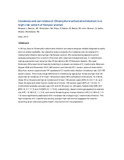Incidence and correlates of Chlamydia trachomatis infection in a high-risk cohort of Kenyan women

View/
Date
2013Author
Masese, L
Baeten, JM
Richardson, BA
Deya, R
Kabare, E
Bukusi, EA
John-Stewart, G
Jaoko Walter G.
McClelland, RS
Type
ArticleLanguage
enMetadata
Show full item recordAbstract
In Africa, data on Chlamydia trachomatis infection are scarce because reliable diagnosis is costly and not widely available. Our objective was to evaluate the incidence and correlates of C. trachomatis infection among high-risk Kenyan women.
We conducted prospective cohort analyses using data from a cohort of women who reported transactional sex. C. trachomatis testing was performed using the Gen-Probe Aptima GC/CT Detection System. We used Andersen-Gill proportional hazards modeling to evaluate correlates of C. trachomatis.
Between August 2006 and December 2010, 865 women contributed 2011 person-years of observation. Sixty-four women experienced 101 episodes of C. trachomatis infection (incidence rate, 5.0/100 person-years). There was a large difference in incidence by age group: those younger than 25 years had an incidence of 27.6 per 100 person-years (95% confidence interval [CI], 16.3-46.5), those 25 to 34 years old had an incidence of 8.4 per 100 person-years (95% CI, 6.4-11.0), and those 35 years and older had an incidence of 2.6 per 100 person-years (95% CI, 1.8-3.6). In multivariate analyses, younger age (<25 and 25-34 years vs. ≥35 years; hazard ratio [HR], 8.5 [95% CI, 4.1-17.7] and 2.9 [95% CI, 1.7-5.0], respectively), depot medroxyprogesterone acetate use (HR, 1.8; 95% CI, 1.1-3.0), and recent Neisseria gonorrhoeae infection (HR, 3.3; 95% CI, 1.5-7.4) were significantly associated with increased risk of acquiring C. trachomatis infection.
The high incidence of C. trachomatis among younger high-risk women suggests the need for screening as an important public health intervention for this population.
URI
www.ncbi.nlm.nih.gov/whalecom0/pubmed/23407467http://erepository.uonbi.ac.ke:8080/xmlui/handle/123456789/32214
Citation
Sex Transm Dis. 2013 Mar;40(3):221-5Collections
- Faculty of Health Sciences (FHS) [10378]
